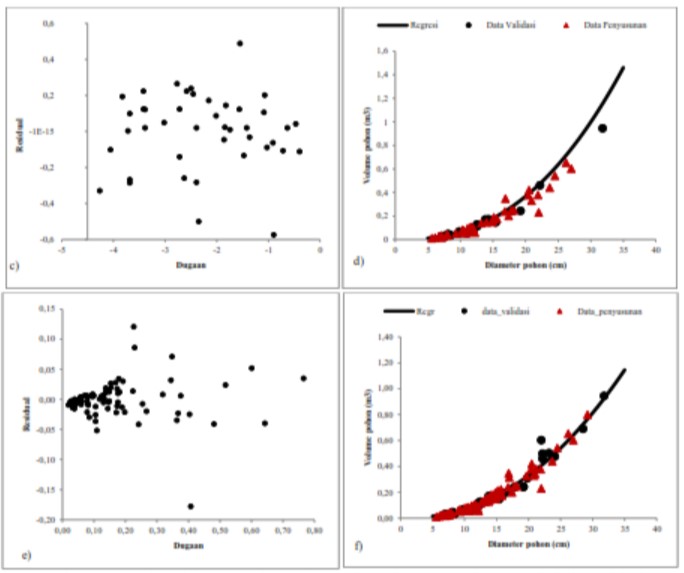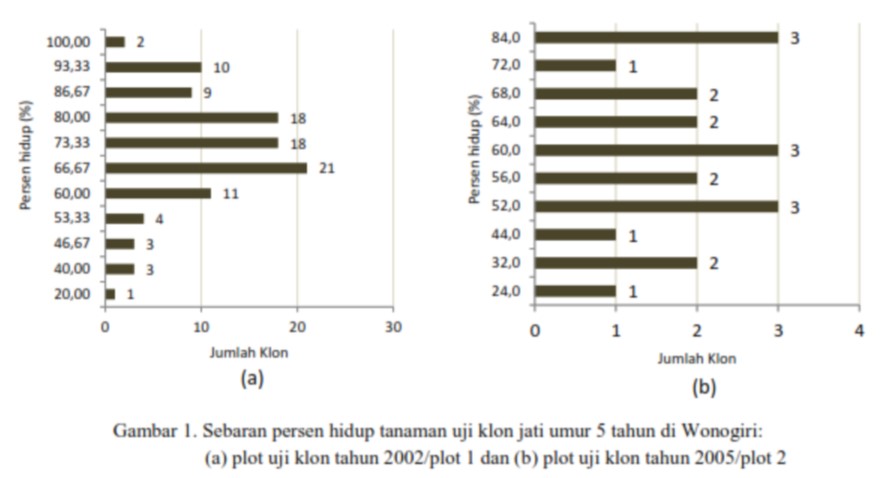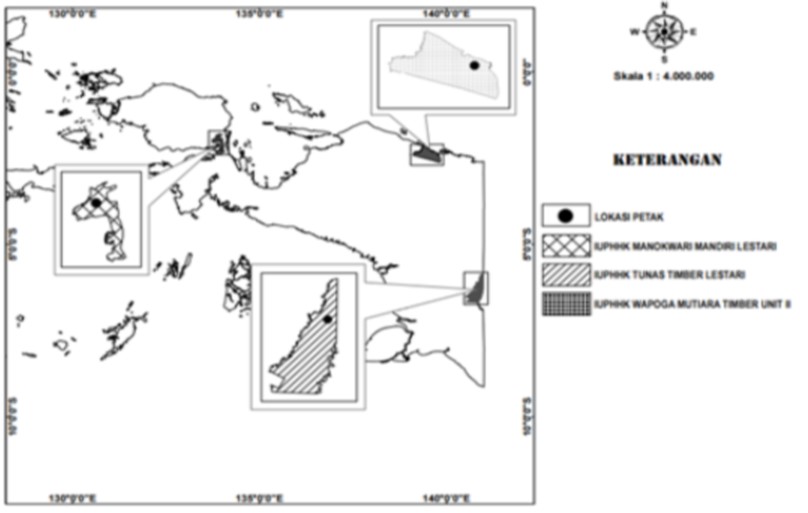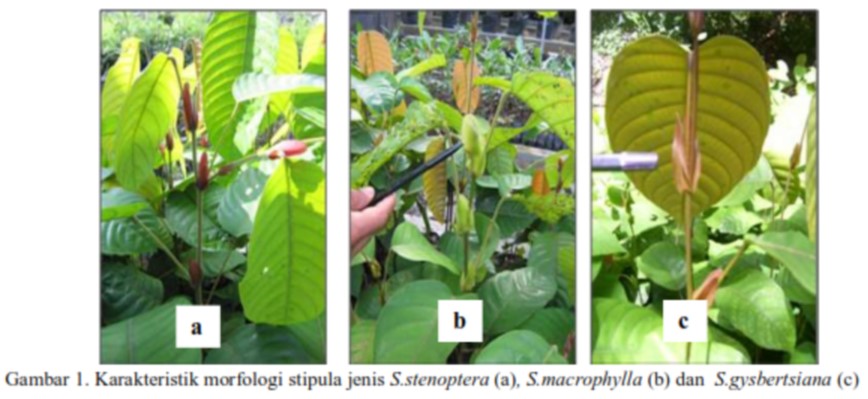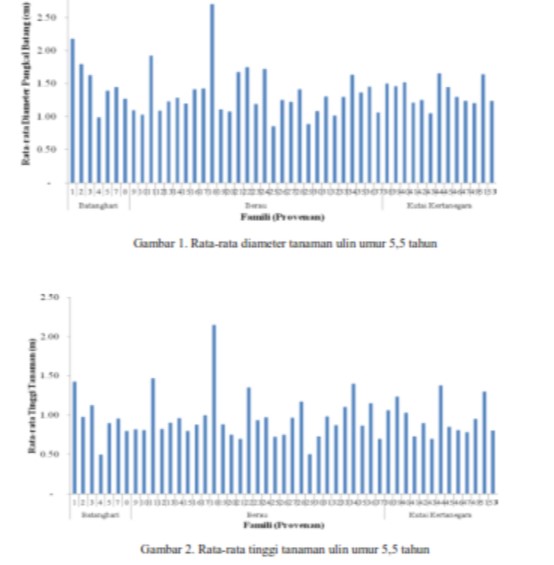Timber Volume Estimation Model for Commercial Tree Species in the Logging Area Concession of PT. Tunas Timber Lestari in Boven Digul, Papua

محتوى المقالة الرئيسي
الملخص
The volume estimation model is one of the most important components in developing sustainable forest management. Nowadays, various models for various types of forests in Indonesia have developed. Nevertheless, these models do not represent the type of forest ecosystem in Papua. Therefore, numerous studies are still needed to develop volume estimation model for various types of forests in Papua. This study was aimed to develop timber volume estimation model for commercial tree species in logging concession of PT. Tunas Timber Lestari in Sesnukt District, Boven Digul Regency, Papua Province. A total of 164 trees were chosen to develop the model and 50 trees for model validation. The result showed that diameter did not have a strong correlation with tree height. Therefore, the model should be developed using the combination of diameter and tree height. The best model in the development stage was selected based on the value of coefficient of determination (R2), standard error of the estimate (SEE), and Ftest. The best model in the validation stage was selected based on the value of bias (e), root mean square errors (RMSE), average deviation (SR), aggregative deviation (SA), and χ2test.. The best model for timber volume estimation in PT. Tunas Timber Lestari are V = 0.00007594 D1.978 H0.923.
تفاصيل المقالة
الحقوق الفكرية (c) 2019 Jurnal Wasian

هذا العمل مرخص بموجب Creative Commons Attribution-NonCommercial 4.0 International License.
Copyright and License
All articles published in Wasian Journal are the property of the authors. By submitting an article to Wasian Journal, authors agree to the following terms:
-
Copyright Ownership: The author(s) retain copyright and full publishing rights without restrictions. Authors grant the journal the right to publish the work first and to distribute it as open access under a Creative Commons Attribution 4.0 International License (CC BY 4.0).
-
Licensing: Articles published in Wasian Journal are licensed under a Creative Commons Attribution 4.0 International License (CC BY 4.0). This license allows others to share, copy, and redistribute the material in any medium or format, and adapt, remix, transform, and build upon the material for any purpose, even commercially, provided that proper credit is given to the original author(s) and the source of the material

This work is licensed under a Creative Commons Attribution 4.0 International License. -
Author's Rights: Authors are permitted and encouraged to post their work online (e.g., in institutional repositories or on their website) prior to and during the submission process, as it can lead to productive exchanges and greater citation of published work.
-
Third-Party Content: If your article contains material (e.g., images, tables, or figures) for which you do not hold copyright, you must obtain permission from the copyright holder to use the material in your article. This permission must include the right for you to grant the journal the rights described above.
-
Reprints and Distribution: Authors have the right to distribute the final published version of their work (e.g., post it to an institutional repository or publish it in a book), provided that the original publication in Wasian Journal is acknowledged.
For the reader you are free to:
- Share — copy and redistribute the material in any medium or format for any purpose, even commercially.
- Adapt — remix, transform, and build upon the material for any purpose, even commercially.
- The licensor cannot revoke these freedoms as long as you follow the license terms.
Under the following terms:
- Attribution — You must give appropriate credit , provide a link to the license, and indicate if changes were made . You may do so in any reasonable manner, but not in any way that suggests the licensor endorses you or your use.
- No additional restrictions — You may not apply legal terms or technological measures that legally restrict others from doing anything the license permits.
Notices:
You do not have to comply with the license for elements of the material in the public domain or where your use is permitted by an applicable exception or limitation .
No warranties are given. The license may not give you all of the permissions necessary for your intended use. For example, other rights such as publicity, privacy, or moral rightsmay limit how you use the material.
Abdurachman. (2012). Tabel volume batang di bawah pangkal tajuk pohon keruing (Dipterocarpus acutangulus) di Labanan Berau Kalimantan Timur. Jurnal Penelitian Dipterokarpa, 6(1), 31-39.
Abdurachman. (2013). Model pendugaan volume pohon Dipterocapus confertus V. Slooten di Wahau Kutai Timur, Kalimantan Timur. Jurnal Penelitian Dipterokarpa, 7(1), 29-34.
Adesoye, P. O., & Popoola, O. D. (2016). Determinants of stem form: application to Tectona grandis (Linn. F) stands. Journal of Sustainable Forestry, 35(5), 338-354. doi: 10.1080/10549811.2016.1177730.
Ardelina, A., Tiryana, T., & Muhdin. (2015). Model volume pohon sengon untuk menilai kehilangan keuntungan petani hutan rakyat. Jurnal Penelitian Hutan Tanaman, 12(2), 131-139.
Basuki, T. M., van Laake, P. E., Skidmore, A. K., & Hussin, Y. A. (2009). Allometric equations for estimating the above-ground biomass in tropical lowland Dipterocarp forests. Forest Ecology and Management, 257, 1684-1694. doi:10.1016/j.foreco.2009.01.027.
Boreel, A., & Siahaya, T. E. (2010). Model pendugaan isi pohon jenis torem (Manilkara kanosiensis, H.J. Lam & B.J.D. Meeuse) di Pulau Yamdena Kabupaten Maluku Tenggara Barat. Jurnal Agroforestry, 5(4), 279-286.
Budiyana, Dewantara, I., & Yani, A. (2018). Analisis angka konversi pengukuran kayu bulat di air untuk jenis meranti (Shorea spp.). Jurnal Hutan Lestari, 6(1), 1-6.
Doyog, N. D., Lumbres, R. I. C., Jung, S. C., Lee, Y. J., & Seo, Y. O. (2019). Stem volume models for Cryptomeria japonica of Jeju Island, Korea. Journal of Sustainable Forestry, 38(5), 442-456. https://doi.org/10.1080/10549811.2019.1570273.
Freund, R. J., Wilson, W. J., & Mohr, D. J. (2010). Statistical Methods (Edisi ke-3). Canada: Academic Press.
Giri, K., Pandey, R., Jayaraj, R. S. C., Nainamalai, R., & Ashutosh, S. (2019). Regression equations for estimating tree volume and biomass of important timber species in Meghalaya, India. Current Science, 116(1), 75-81.
Gonzalez-Benecke, C. A., Gezan, S. A., Samuelson, L. J., Cropper Jr., W. P., Leduc, D. J., & Martin, T. A. (2014). Estimating Pinus palustris tree diameter and stem volume from tree height, crown area and stand-level parameters. Journal of Forestry Research, 25(1), 43-52. doi: 10.1007/s11676-014-0427-4.
Guedes, B. S., Sitoe, A. A., & Olsson, B. A. (2018). Allometric models for managing lowland miombo woodlands of the Beira corridor in Mozambique. Global Ecology and Conservation, 13, 1-15. doi: 10.1016/j.gecco.2018.e00374.
Guendehou, G. H. S., Lehtonen, A., Moudachirou, M., Mäkipää, R., & Sinsin, B. (2012). Stem biomass and volume models of selected tropical tree species in West Africa. Southern Forest: A Journal of Forest Science, 74(2), 77-88. doi: 10.2989/20702620.2012.701432.
Holopainen, M., Vastaranta, M., Rasinmaki, J., Kalliovirta, J., Makinen, A., Haapanen, & R., Hyyppa, J. (2010). Uncertainty in timber assortment estimates predicted from forest inventory data. European Journal of Forestry Research, 129(6), 1131-1142. doi: 10.1007/s10342-010-0401-4.
Imani, G., Boyemba, F., Lewis, S., Nabahungu, N. L., Calders, K., Zapfack, L., … Cuni-Sanchez, A. (2017). Height-diameter allometry and above ground biomass in tropical montane forests: insights from the Albertine Rift in Africa. PloS ONE, 12(6), 1-20. doi: 10.1371/journal.pone.0179653.
Johansson, T. (2014). Total stem and merchantable volume equations of Norway Spruce (Picea abies (L.) Karst.) growing on former farmland in Sweden. Forests, 5(8), 2037-2049. doi: 10.3390/f5082037.
Kesuma, R. A., Kustanti, A., & Hilmanto, R. (2016). Pertumbuhan riap diameter pohon bakau kurap (Rhizophora mucronata) di Lampung Mangrove Center. Jurnal Sylva Lestari, 4(3), 97-106.
Kitikidou, K., Milios, E., & Lipiridis, I. (2014). Tree volume model estimates and nearest neighbour analysis in the stands of Scots pine (Pinus sylvestris L.) in the central part of Rodope Mountain. Sumarski List, 138(11-12), 573-582.
Krisnawati, H., & Bustomi, S. (2004). Model penduga isi pohon bebas cabang jenis sungkai (Peronema canescens Jack.) di KPH Banten. Buletin Penelitian Hutan, 644, 39-50.
Krisnawati, H., Kallio, M., & Kanninen, M. (2011). Swietenia macrophylla King: Ecology, Silviculture, and Productivity. Bogor: CIFOR.
Krisnawati, H., Adinugroho, W. C., & Imanuddin, R. (2012). Monograf Model-Model Allometrik untuk Pendugaan Biomassa Pohon pada Berbagai Tipe Ekosistem Hutan di Indonesia. Bogor: Pusat Penelitian dan Pengembangan Konservasi dan Rehabilitasi.
Kuswandi, R., Sadono, R., Supriyatno, N., & Marsono, D. (2015). Keanekaragaman struktur tegakan hutan alam bekas tebangan berdasarkan biogeografi di Papua. Jurnal Manusia dan Lingkungan, 22(2), 151-159.
Kuswandi, R. (2016). Model penduga volume pohon kelompok jenis komersial pada wilayah Kabupaten Sarmi, Papua. Jurnal Wasian, 3(2), 91-96.
Malata, H., Ngulube, E. S., & Missanjo, E. (2017). Site specific stem volume models for Pinus patula and Pinus oocarpa. International Journal of Forestry Research, 2017, 1-6. https://doi.org/10.1155/2017/3981647.
Mauya, E. W., Mugasha, W. A., Zahabu, E., Bollandsås, O. M., & Eid, T. (2014). Models for estimation of tree volume in the miombo woodlands of Tanzania. Southern Forest: A Journal of Forest Science, 76(4), 209-219. doi: 10.2989/20702620.2014.957594.
McCormick, K., Salcedo, J., & Poh, A. (2015). SPSS for Dummies (Edisi ke-3). New Jersey: John Wiley & Sons.
McRoberts, R. E., & Westfall, J. A. (2014). Effects of uncertainty in model predictions of individual tree volume on large area volume estimates. Forest Science, 60(1), 34-42. http://dx.doi.org/10.5849/forsci.12-141.
Menendéz-Miguélez, M., Canga, E., Álvarez-Álvarez, P., & Majada, J. (2014). Stem taper function for sweet chestnut (Castanea sativa Mill.) coppice stands in northwest Spain. Annals of Forest Science, 71, 761-770. doi: 10.1007/s13595-014-0372-6.
Mensah, S., Veldtman, R., & Seifert, T. (2017). Allometric models for height and aboveground biomass of dominant three species in South African Mistbelt forests. Southern Forests: A Journal of Forest Science, 79(1), 19-30. doi: 10.2989/20702620.2016.1225187.
Mugasha, W. A., Mwakalukwa, E. E., Luoga, E., Malimbwi, R. E., Zahabu, E., Silayo, D. S., … Kashindye, A. (2016). Allometric models for estimating tree volume and above ground biomass in lowland forests of Tanzania. International Journal of Forestry Research, 2016, 1-13. doi: 10.1155/2016/8076271.
Qirom, M. A., & Supriadi. (2012). Penyusunan model penduga volume pohon jenis jelutung rawa (Dyera polyphylla (Miq) V. Steenis). Jurnal Penelitian Hutan Tanaman, 9(3), 141-153.
Qirom, M. A., & Supriyadi. (2013). Model penduga volume pohon nyawai (Ficus variegata Blume) di Kalimantan Timur. Jurnal Penelitian Hutan Tanaman, 10(4), 173-184.
Qirom, M. A. (2018). Penyusunan dan validasi model penduga volume jenis pohon balangeran (Shorea balangeran (Korth.) Burck) di Kalimantan Tengah. Jurnal Wasian, 5(2), 89-103.
Riady, A. (2011). Penyusunan dan Validasi Persamaan Tabel Volume Lokal Pohon Meranti (Shorea spp.) di Areal PT. Intaracawood Manufacturing, Kalimantan Timur. Skripsi tidak diterbitkan, Institut Pertanian Bogor, Bogor.
Sadono, R., Trisnomo, M. D., & Askar. (2009). Model lengkung bentuk batang (taper curve) pohon jati (Tectona grandis). Jurnal Ilmu Kehutanan, 3(1), 35-43.
Sahuri. (2017). Model pendugaan volume pohon karet saat peremajaan di Sembawa, Sumatera Selatan. Jurnal Penelitian Hutan Tanaman, 14(2), 107-112.
Siagian, K. (2011). Tabel Volume Pohon Agathis loranthifolia di Hutan Pendidikan Gunung Walat Kabupaten Sukabumi Provinsi Jawa Barat. Skripsi tidak diterbitkan, Institut Pertanian Bogor, Bogor.
Siarudin, M., & Indrajaya, Y. (2014). Persamaan allometrik jabon (Neolamarckia cadamba Miq) untuk pendugaan biomassa di atas tanah pada hutan rakyat Kecamatan Pakenjeng Kabupaten Garut. Jurnal Penelitian Hutan Tanaman, 11(1), 1-9.
Siswanto, B. E., Wahjono, D., Harbagung, & Imanuddin, R. (2007). Ketepatgunaan berbagai model pendugaan volume pohon jenis kayu sibu (Timonius nitens M.et.P.) di wilayah Kecamatan Mandobo, Kabupaten Merauke, Provinsi Papua. Jurnal Penelitian Hutan dan Konservasi Alam, 4(3), 291-299.
Subedi, M. R., & Sharma, R. P. (2012). Allometric biomass models for bark of Cinnamomum tamala in mid-hill of Nepal. Biomass and Bioenergi, 47, 44-49.
Sumadi, A., Nugroho, A. W., & Rahman, T. (2010). Model penduga volume pohon pulai gading di Kabupaten Musi Rawas – Sumatera Selatan. Jurnal Penelitian Hutan Tanaman, 7(2), 107-112.
Sumadi, A., & Siahaan, H. (2010). Model penduga volume pohon kayu bawang (Disoxylum molliscimum Burm F.) di Provinsi Bengkulu. Jurnal Penelitian Hutan Tanaman, 7(5), 227-231.
Sumida, A., Miyaura, T., & Torii, H. (2013). Relationships of tree height and diameter at breast heigh revisited: analyses of stem growth using 20-year data of an even-aged Chamaecyparis obtusa stand. Tree Physiology, 33, 106-118. doi: 0.1093/treephys/tps127
Surat Keputusan Menteri Kehutanan (2003). Pengelompokan Jenis Kayu sebagai Dasar Pengenaan Iuran Kehutanan dengan Beberapa Penyesuaian (SK Menhut No.163/Kpts-II/2003).
Susanty, F. H., & Abdurachman. (2016). Analisis penyusunan model penduga volume pohon 3 jenis shorea di Tarakan, Kalimantan Utara. Jurnal Penelitian Ekosistem Dipterokarpa, 2(1), 29-40.
Susila, I. W. W. (2012). Model pendugaan volume dan riap tegakan jati (Tectona grandis L.F) di Nusa Penida, Klungkung Bali. Jurnal Penelitian Hutan Tanaman, 9(3), 165-178.
Susila, I. W. W., & Darwo. (2015). Riap dan dugaan volume tegakan ampupu (Eucalyptus urophylla S.T. Blake) di kawasan hutan Wololobo, Bajawa Flores. Jurnal Penelitian Hutan Tanaman, 12(2), 105-113.
Tewari, V. D., Mariswamy, K. M., & Arunkumar, A. N. (2013). Total and merchantable volume equations for Tectona grandis Linn. f. plantations in Karnataka, India. Journal of Sustainable Forestry, 32(3), 213-229. doi: 10.1080/10549811.2013.762187.
Tiryana, T., Tatsuhara, S., & Shiraishi, N. (2011). Empirical models for estimating the stand biomass of teak plantations in Java, Indonesia. Journal of Forest Planning, 16, 177-188.
Tunas Timber Lestari. (2013). Rencana Kerja Tahunan IUPHHK PT. Tunas Timber Lestari Tahun 2013. Boven Digul: PT. Tunas Timber Lestari.
Ver Planck, N. R., & MacFarlane, D. W. (2014). Modelling vertical allocation of tree stem and branch volume for hardwoods. Forestry, 87, 459-469. doi: 10.1093/forestry/cpu007.
Yulianti, M. (2012). Penyusunan tabel volume lokal jabon (Anthocephalus cadamba) di hutan rakyat Desa Punggelan, Kecamatan Punggelan, Banjarnegara, Jawa Tengah. Tekno Hutan Tanaman, 5(2), 73-78.


